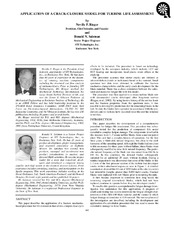| dc.contributor.other | Turbomachinery Symposium (34th : 2005) | |
| dc.creator | Rieger, Neville F. | |
| dc.creator | Salzman, Ronald N. | |
| dc.date.accessioned | 2017-10-04T23:01:08Z | |
| dc.date.available | 2017-10-04T23:01:08Z | |
| dc.date.issued | 2005 | |
| dc.identifier.uri | https://hdl.handle.net/1969.1/163227 | |
| dc.description | Lecture | en |
| dc.description | Pg. 105-110 | en |
| dc.description.abstract | This paper describes the application of a fracture mechanics-based procedure for life estimation that allows complex load cycle effects to be included. The procedure is based on technology developed by the aerospace industry, which includes LCF and HCF loading and incorporates local plastic strain effects at the crack tip. The procedure assumes that starter cracks are initiated at inherent defects (voids or inclusions) found in the material. Small specimen test data were obtained to calibrate the fracture mechanics characteristics and the early crack development for the blade material. There was a close correlation between the calculated and measured fatigue life with this model. The procedure was then applied to a steam turbine blade row with documented cracks developed after long-term service (Rieger, et al., 2002). By using known history of the service loads and the fracture properties from the specimen tests, it was possible to develop life predictions for the remaining blades in the row. To date the blades have operated in accordance with the predictions and no failures have occurred since the unit has returned to service. | en |
| dc.format.medium | Electronic | en |
| dc.format.mimetype | application/pdf | |
| dc.language.iso | en | |
| dc.publisher | Texas A&M University. Turbomachinery Laboratories | |
| dc.relation.ispartof | Proceedings of the 34th Turbomachinery Symposium | en |
| dc.subject.lcsh | Turbomachines | en |
| dc.title | Application Of A Crack-Closure Model For Turbine Life Assessment. | en |
| dc.type.genre | Presentation | en |
| dc.type.material | Text | en |
| dc.identifier.doi | https://doi.org/10.21423/R1MM2T | |


